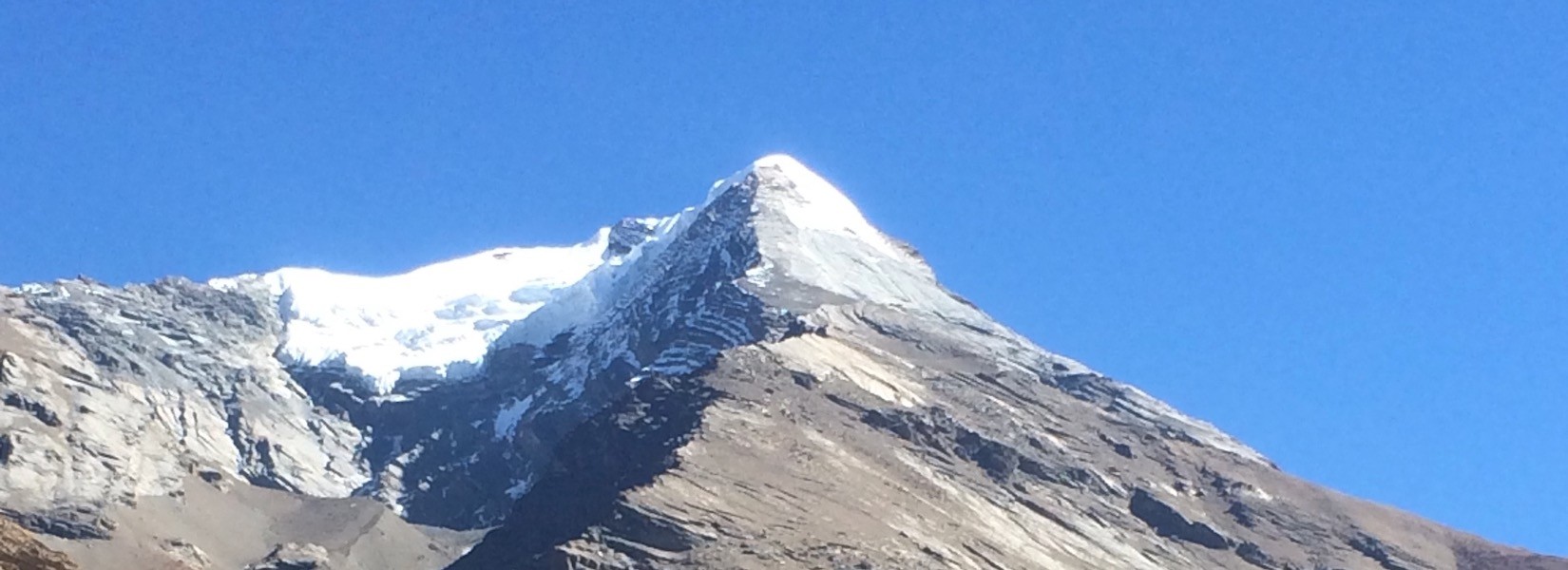Climbing Pisang Peak (6,091 m) is a moderately difficult mountaineering challenge. Pisang Peak lies between Annapurna (8,091m) and Manalsu (8,163m) region. This program is combined with a part of the renowned Annapurna Circuit trek. Therefore, it is gaining a popularity among aspiring mountaineers. Pisang Peak does not demand high resilience or good mountaineering skills. If you are one with a desire to climb trekking peaks of Nepal, that alone would suffice in the first place.
The Thakali, Manangese and mixed community villages are also the striking features to make this adventurous journey in Nepal more vibrant. The Tibetan Monasteries, Mountaineering School of Manang add to the beauty of this trekking and climbing package. The Typical Thakali cuisine (daal bhaat and fermented green vegetables pickle) is something you shouldn’t miss while visiting Manang Valley.
The variation of geography ranging from sub-tropical to desert-like region of Manang Valley is another thrilling aspect of this trip. You can witness the paddy, wheat, barley and potato fields to barren landscapes while ascending and descending towards the destination. The dense forests of rhododendron, oak and pine trees are really beautiful feature to experience once in lifetime. The variety of animal and bird species inhabiting in the Annapurna Conservation Area (ACA) contribute to give you lifelong memory.
Our route is through the the Annapurna Circuit from Beshishahar to the village of Pisang. From here, the base camp can be reached on a single day, at an altitude of about 4,380 meters. The base camp for Pisang Peak is laid out in a pasture. From here, we move up to the High Camp (5,400 m) at a saddle in South-western ridge. The final ascent, consisting of steep inclinations of ice and snow up to the summit is done by following the same ridge.
Although this part is challenging, ascent up Pisang peak is relatively undemanding. From the top of the peak, you can enjoy astounding views of peaks of the Annapurna (8,091m) Range. Annapurna II, Annapurna IV, Gangapurna and Glacier Dome – all are visible from one single spot of joy. Later in the day, you descend to the base camp and begin the journey onwards.
On your way back, you can trek in the beautiful valley of Manang over the world’s highest pass, Thorang-La (5,416 m). From there, descend to Muktinath and then to Jomsom from where you can catch a flight to Pokhara. Muktinath Temple is one of the major shrines of Nepal equally respected by Hindus and Buddhists. The ever-burning flame with the natural gas and the 108 waterspouts are the main attractions of this shrine. Every year, hundreds of thousand pilgrims from India and Nepal visit this sacred place in different season.
FAQs:
1. Where is Pisang Peak?
Pisang Peak (6,091m) is one of the trekking peaks of Nepal located in Annapurna region between Annapurna region and Manaslu (8.163m) region. It is one of the frequently climbed peak in the Manang Valley. It requires around 7/8 days to complete Pisang Peak climbing from Pokhara.
2. How difficult is Pisang Peak climbing?
It is moderately challenging to climb Pisang Peak. The trail from High Camp to Pisang Peak Summit is challenging due to some crevasses. However, if you are determined and with little knowledge about using climbing gears, you can easily do it away. Moreover, the Sherpa guide who leads your team gives you all the skills and techniques to win over this trekking peak. Acclimatization also plays a great role to accomplish this task. Follow the instructions of the climbing guide by taking enough rest to beat this climbing in Nepal. Besides, don’t forget to have enough drinking water and hygienic food items to remain physically fit.
3. Can I customize Pisang Peak climbing package?
Yes, you can definitely customize this package. You can cut short the package by choosing Pisang Peak climbing and return to Pokhara or Kathmandu right from Manang. Or you can extend the itinerary by choosing to Thorung La Muktinath Mustang trek. The second option gives you a lifelong memory of crossing one of the highest altitude Himalayan passes in the world.
4. How can I book Pisang Peak climbing package?
Nowadays, the information about Pisang Peak climbing details about itinerary, cost and difficulty are uploaded on the Internet. You can search it on the web and book it through the local tour and trekking operator located in Kathmandu. Among the local agencies, Orbit Alpine Adventure is the one run by the Nepalese who has done peak climbing in Everest, Langtang and Annapurna including Pisang Peak climbing many times. To get help from us, click www.orbitalpineadventure.com.
5. What is the best time for Pisang Peak climbing?
The best time for Pisang Peak climbing is from mid March to mid May and from mid September to mid December. In this time, it is easy to climb the peak as there is less snow deposit on the trail. Next, you can have a 360-degree panoramic view of snowcapped peaks and wonderful landscapes from the top of Pisang Peak.
6. Do I need climbing gears to climb Pisang Peak?
Yes, you do. Although climbing Pisang Peak is not much difficult, you need to be fully prepared for this mission. You need to bring climbing gears and should have knowledge about using them properly. The peak climbing gears are like this:
|
Fixed Rope |
Climbing Rope |
Tent |
Crampons |
|
Altimeter Watch |
Ice Axe |
Sleeping Bag |
Waterproof Trousers |
|
Gas Stove |
Gas Fuel |
Ascender (Jumar) |
Mattress |
|
Figure 8/ Descender |
Carabiner |
Tape Slings |
Harness |
|
Helmets |
Ice Screw |
Belay Gloves |
Ski Goggles |
|
Headlamps |
Trekking Poles/ Ski Poles |
Snow Shovel |
|
|
Large Thermos |
Water Bottle |
Mountaineering Jackets |
|
|
Cooking Pots and Equipment |
Mountaineering/ Climbing Boots |
||
|
Climbing Backpacks |
|
||






